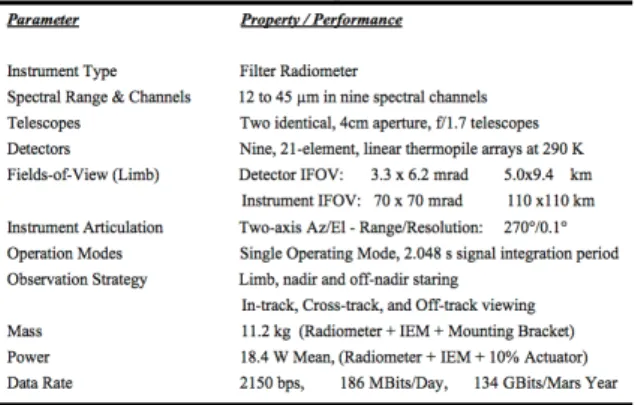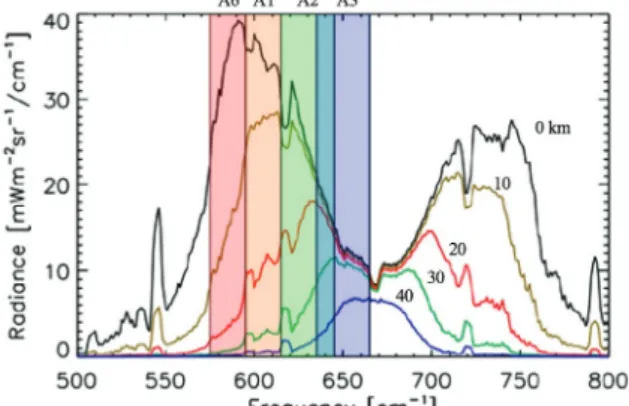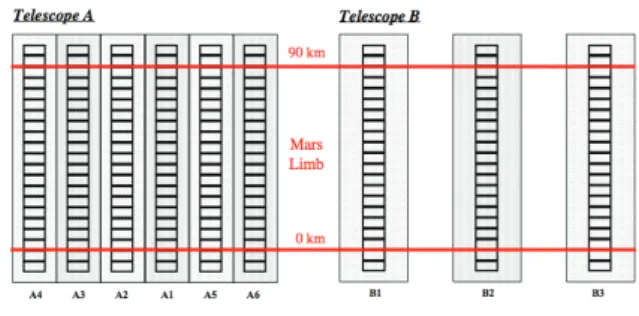HAL Id: hal-00569133
https://hal.archives-ouvertes.fr/hal-00569133
Submitted on 24 Feb 2011HAL is a multi-disciplinary open access archive for the deposit and dissemination of sci-entific research documents, whether they are pub-lished or not. The documents may come from teaching and research institutions in France or abroad, or from public or private research centers.
L’archive ouverte pluridisciplinaire HAL, est destinée au dépôt et à la diffusion de documents scientifiques de niveau recherche, publiés ou non, émanant des établissements d’enseignement et de recherche français ou étrangers, des laboratoires publics ou privés.
The Exomars Climate Sounder (EMCS) Investigation
J. T. Schofield, D. M. Kass, A. Kleinböhl, D. J. Mccleese, M. A. Allen, M. C.
Foote, M. Jeganathan, François Forget, A. Spiga, O. Talagrand, et al.
To cite this version:
J. T. Schofield, D. M. Kass, A. Kleinböhl, D. J. Mccleese, M. A. Allen, et al.. The Exomars Climate Sounder (EMCS) Investigation. Fourth International Workshop on the Mars Atmosphere: Modelling and Observations, Feb 2011, Paris, France. 5 p. �hal-00569133�
THE EXOMARS CLIMATE SOUNDER (EMCS) INVESTIGATION.
J. T. Schofield, D. M. Kass, A. Kleinböhl, D. J. McCleese, M. A. Allen, M. C. Foote, M. Jeganathan, Jet
Propulsion Laboratory, California Institute of Technology, Pasadena, California, USA, (John.T.Schofield@jpl.nasa.gov), F. Forget, A. Spiga, O. Talagrand, Laboratoire de Météorologie Dynami-que, ISPL, CNRS, Paris, France, F. Lefèvre, A. Määttänen, Laboratoire Atmosphères, Milieux, Observations Spatiale, Paris, France, T. Fouchet, Laboratoire d’Ètudes Spatiales et d’Instrumentation en
Astrophysi-que, Observatoire de Paris, Paris, France, N. Bowles, S. B. Calcutt, P. G. J. Irwin, P. L. Read, Atmos-pheric, Oceanic and Planetary Physics, Department of Physics, University of Oxford, UK, S. R. Lewis, De-partment of Physics and Astronomy, The Open University, Milton Keynes, UK, J. R. Barnes, Oregon State University, Corvallis, Oregon, USA, S. W. Bougher, AOSS Department, University of Michigan, Ann Arbor, Michigan, USA, R. M. Haberle, NASA/Ames Research center, Moffett Field, California, USA.
Introduction:
The ExoMars Climate Sounder (EMCS) investi-gation plans to map daily, global, pole-to-pole pro-files of temperature, dust, water and CO2 ices, and water vapor from the proposed 2016 ExoMars Trace Gas Orbiter (EMTGO). The measurements cover all local times, adding a new dimension to data pre-viously obtained from sun-synchronous spacecraft. These profiles are to be assimilated into Mars Gen-eral Circulation Models (MGCMs) to generate glob-al, interpolated fields of measured and derived pa-rameters such as wind.
Measured and assimilated fields from EMCS clearly delineate the diurnal, day-to-day, and season-al variation of atmospheric state. Temperature and aerosol fields are essential for characterizing photo-chemical processes and heterogeneous chemistry, water vapor acts as a key source gas for odd hydro-gen (HOx) photochemistry in the Martian atmos-phere, and the wind field is critical for localizing the sources that govern the distribution of trace gases measured by other proposed EMTGO instruments..
Figure 1 – The MRO/MCS instrument during ther-mal vacuum testing at JPL
EMCS is a copy of the Mars Climate Sounder (MCS) instrument on the Mars Reconnaissance Or-biter (MRO) spacecraft [McCleese et al., 2007], with low impact modifications to 2 of 9 spectral filters and for interfaces with the proposed EMTGO space-craft. MCS is now in its 5th year of returning atmos-pheric profiles from Mars [McCleese et al., 2008]. The MCS flight instrument is shown in Figure 1.
EMCS is an infrared, limb sounding, filter radi-ometer which uses 9 spectral channels from 12 - 45
µm to address its measurement objectives. EMCS instrument parameters are summarized in Table 1. The 270° elevation/azimuth articulation of the in-strument provides full coverage of the downward hemisphere allowing limb observations in all direc-tions and giving daily, global, pole-to-pole coverage of Mars from the 74 ± 10° inclination EMTGO orbit. Uncooled, 21-element, linear thermopile arrays in each spectral channel are the enabling technology of EMCS, permitting atmospheric profiles to be derived from limb staring observations with better sensitivity and geometrical stability than limb scanning.
Table 1 – EMCS instrument parameters.
Science and Measurement Objectives:
The baseline science and measurement objectives of the EMCS investigation are to:
Enhance understanding of Mars photochemi-stry by providing daily, global, high vertical resolu-tion fields of atmospheric state, aerosol distribu-tion, and water vapor concentration.
EMCS atmospheric state measurements, com-bined with data assimilation, characterize the trans-port, sources and sinks of trace gases measured by the proposed EMTGO. The aerosol measurements reveal the heterogeneous photochemical pathways of trace gases. EMCS plans to map water vapor, the key source gas for odd hydrogen, known to be im-portant in martian photochemistry.
Extend the MRO/MCS climatology of high vertical resolution measure-ments of the lower and middle at-mosphere of Mars, with the improved
coverage of local time provided by the proposed EMTGO.
EMCS would determine the diurnal, seasonal & long-term variability of temperature and aerosol, and its impact on photochemistry. EMCS climatology, combined with earlier data, would relate EMTGO observations to earlier trace gas measurements.
Support future Mars missions with measured climatology and near real-time density profile re-trievals for landing and aerocapture, in the same way that MRO/MCS supported the Phoenix land-ing and is supportland-ing the Mars Science Laboratory (MSL) landing.
EMCS could be the only instrument in orbit able to support Entry, Descent and Landing (EDL) for the proposed ExoMars 2018 Rover Mission.
French and UK Co-Investigators make a key con-tribution to the EMCS investigation. The European component of the science team assimilates measured atmospheric fields into Mars General Circulation Models. The assimilation scheme is being developed using MRO/MCS data and will provide the derived fields, such as wind, needed to understand the trans-port, sources, and sinks of trace gases.
Based on the performance of MRO/MCS, and water vapor retrieval simulations, EMCS obtains atmospheric profiles with an accuracy of 1 - 2 K in temperature, < 0.0001 km-1 in aerosol opacity, and < 10 ppm (0.7 pr.µm) in water vapor mixing ratio, with 5 km vertical resolution and 0 - 90 km vertical coverage. This vertical resolution is necessary to resolve important atmospheric structure and to match the high vertical resolution trace gas measurements of the microwave and solar occultation instruments.
The 270° elevation and azimuth articulation of EMCS gives the instrument 360° coverage of the limb. This allows EMCS to compensate for space-craft yaw and obtain pole-to-pole coverage every orbit, with daily resolution of 3.5° latitude and 30° longitude. By combining in-track limb and nadir observations, retrieved profiles could be extended to the surface over much of the planet.
EMCS measurements are uniquely synergistic with the rest of the proposed EMTGO payload. They would provide daily global fields to supplement the more sparsely sampled solar occultations, and supply the dust and ice opacities not available to microwave measurements. Furthermore, the articulation pro-vided by the actuators allows coincident measure-ments with occultation, limb, and nadir sounding instruments regardless of their orientation on the spacecraft.
Spectral Channel Selection:
Table 2 summarizes the coverage of the nine EMCS spectral channels, their distribution between the two instrument telescopes, and the primary mea-surement function of each channel. With the
excep-tion of A6, their funcexcep-tions are identical to those of MRO/MCS. A6 was a broad-band visible channel, designed for polar radiative balance measurements, which cannot be addressed from the 74° inclination proposed EMTGO orbit. It has been replaced by a spectral interval designed to improve low altitude temperature and CO2 ice extinction profiling.
Table 1 – The response and measurement function of the nine EMCS spectral channels.
Figure 2 compares the four EMCS temperature sounding channels with atmospheric limb emission spectra calculated for five tangent altitudes. The cal-culations were performed at high spectral resolution by the MCS line-by-line transmission code and were smoothed to 5 cm-1 for clarity. The spectra are domi-nated by emission from the 15-micron band of CO2. As noted in Table 2, the channels are optimized for different altitude ranges by placing them at differing opacities in the long-wavelength wing of the band. As the spectroscopy and mixing ratio of CO2 are well known, these channels allow accurate mea-surements of temperature. Pressure is also derived from the ratio of A3 and A2 measurements.
Figure 2 - EMCS temperature sounding channels.
Figure 3 compares the EMCS aerosol sounding channels with extinction efficiency spectra calcu-lated for dust, water ice, and CO2 ice models. These calculations assume Mie scattering, with particle sizes described by modified gamma distribution functions. The model effective radii are 1.06 µm for dust, 1.41 µm for water ice, and 2.0 µm for CO2 ice. The strong absorption feature of CO2 ice is masked by the gaseous CO2 band but, when the atmosphere is cold, A6 is sensitive primarily to CO2 ice. The B
telescope channels provide sensitivity to aerosols at higher opacities in the limb path, when A4 and A5 are opaque, and also to water ice at low temperatures when the concentration of water vapor is negligible.
Figure 3 - EMCS dust and ice channels.
Figure 4 compares the EMCS water vapor chan-nels with water vapor limb emission spectra. A con-stant water vapor volume mixing ratio of 300 ppm is assumed (~20 pr.µm). The relatively broad channel, B2, contains two strong water vapor emission fea-tures, whereas the narrow channel B3 is centered on a window in the water vapor spectrum. These co-centered channels have very similar responses to aerosol opacity, but very different responses to water vapor, allowing the two components to be separated.
Figure 4 - EMCS water vapor channels.
Limb Staring and Vertical Resolution:
The half scale height (5 km) resolution needed to reveal key atmospheric structure is made possible by limb-viewing geometry and the 5-km field-of-view of the EMCS instrument. Micro-machined thermo-pile arrays are the enabling technology that allows limb staring. Compared with scanning a single de-tector across the limb, limb staring provides im-proved signal-to-noise and greatly reduces the sensi-tivity of measurements to spacecraft pointing drifts.
Figure 5 - Nominal EMCS detector fields-of-view.
Figure 5 shows a schematic of the nominal EMCS fields of view projected on the limb of Mars from the nominal 400-km orbit, with the surface and 90 km levels indicated. Both telescopes, including all 189 detectors, are represented. The telescope fields-of-view are coincident, with arrays A4/B1 and A6/B3 superimposed. They are separated for clarity.
The true vertical resolution of each measurement is determined by the limb path through the atmos-phere as well as by its geometrical FOV. Figure 6 shows a retrieved MCS temperature profile together with a corresponding set of vertical response or weighting functions for the EMCS temperature sounding channels (Figure 2).
Figure 6 - EMCS weighting functions derived for a retrieved martian temperature profile.
Atmospheric Profile Retrievals:
The retrieval of atmospheric profiles from EMCS radiances is based on a modified Chahine method [Chahine, 1970]. The team of Co-Is at JPL has ex-tensive experience with this technique and its adap-tation for limb-viewing radiometers, as the approach has been successfully implemented for MRO/MCS [Kleinböhl et al., 2009]. The retrieval code contains a fast radiative transfer scheme, which includes sin-gle scattering of radiation from aerosol. Profiles of temperature, pressure, dust and water ice opacity are retrieved simultaneously. For in-track measurements, retrievals are based on a combination of co-located limb and nadir measurements. The latter provide surface temperature, aerosol and water vapor column quantities, and improved temperature profiles near the surface. For off-track measurements, where co-located nadir measurements are not available, the temperature near the surface can be retrieved with the new A6 channel (Figure 6).
Figure 7 - Transect of MCS temperature (top), dust opacity (middle) and water ice opacity (bottom) re-trievals for a single orbit at Ls = 155° (12/23/2006).
Figure 7 shows a nighttime pole-to-pole transect of combined limb-nadir retrievals from MRO/MCS for a single orbit. The dashed lines indicate the indi-vidual profiles, and their slope is due to the altitude dependence of tangent point location. Temperature profiles are retrieved up to ~90 km altitude with a typical precision between 0.5 and 2 K over most of this altitude range. Errors tend to be larger only at very high altitudes and very low temperatures. Pres-sure is retrieved to a precision of 1 - 2% at 20 - 30 km, and profiles of dust and water ice extinction achieve precisions of 10-4 - 10-5 km-1.
Figure 8 - One day of night-time temperature cover-age of Mars from MRO/MCS.
Figure 8 shows 24 hours of MRO/MCS tempera-ture retrievals displayed as curtains overlaid on Mars altimetry using Google Earth. The season is northern spring (Ls = 39°) and the curtains show temperatures from 0-80 km with a vertical resolution of 5 km ranging from 120 K (purple) to 200 K (green).
Mission Operations:
Figure 9 - EMCS 24 hr coverage of the northern hemisphere of Mars from the TGO orbit.
EMCS plans to operate continuously, day and night, from the nadir-oriented spacecraft platform provided by the proposed EMTGO spacecraft. Ob-servational flexibility is supplied by azi-muth/elevation scanning, driven by scan tables stored in the instrument and timed relative to an equator crossing time command. Modifications to the observational strategy would be implemented by uploading scan tables, but observations are able to continue indefinitely without commanding.
EMCS observations fall into the following cate-gories. 1) Routine, repetitive, in-track and off-track limb and nadir sounding from pole-to-pole, using the azimuth actuator to compensate for spacecraft yaw. 2) Routine calibration measurements using views of space and the instrument blackbody targets. 3) Cam-paigns make simultaneous and coincident measure-ments with other instrumeasure-ments.
An example of the daily global coverage achieved by 1) above, from the 400 km, 74° inclina-tion nominal orbit is shown in Figure 9. In-track observations reach 74°N and measurements made 40° off-track extend to the pole.
Data Products:
The EMCS investigation has a data analysis and archiving plan that builds strongly on MCS heritage. Table 3 summarizes the planned EMCS data prod-ucts, plans for data generation, validation, reprocess-ing, and schedules and estimated volumes for deli-very to the atmospheres node of the Planetary Data System (PDS). Team members responsible for prod-ucts are indicated. This effort builds on MRO/MCS operational, software and hardware heritage.
References:
Chahine, M. T., 1970, Inverse problems in radia-tive transfer: Determination of atmospheric parame-ters, J. Atmos. Sci. 27, 960-967.
McCleese, et al., 2007, Mars Climate Sounder: An investigation of thermal and water vapor struc-ture, dust and condensate distributions in the atmos-phere, and energy balance of the polar regions, J.
Geophys. Res., 112, E05S06, doi:10.1029/2006
JE002790.
McCleese, et al., 2008, Intense polar tempera-ture inversion in the middle atmosphere on Mars,
Nature Geoscience 1, 745-749.
Kleinböhl, et al., 2009, Mars Climate Sounder limb profile retrieval of atmospheric temperature, pressure, and dust and water ice opacity, J. Geophys.
Res. 114, E10006, doi:10.1029/2009JE003358. This work was performed at the Jet Propulsion Laboratory, California Institute of Technology under contract to NASA.


